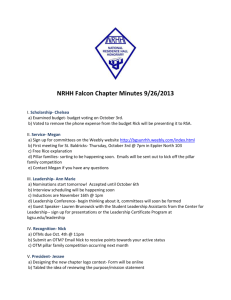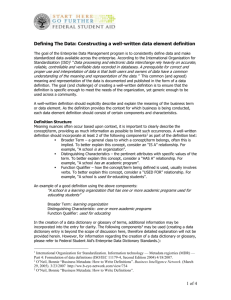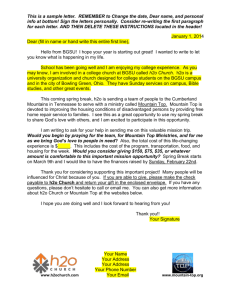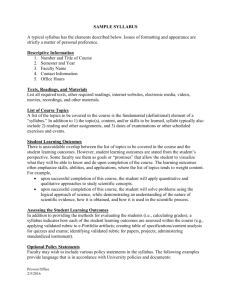will i have enough financial aid?
advertisement
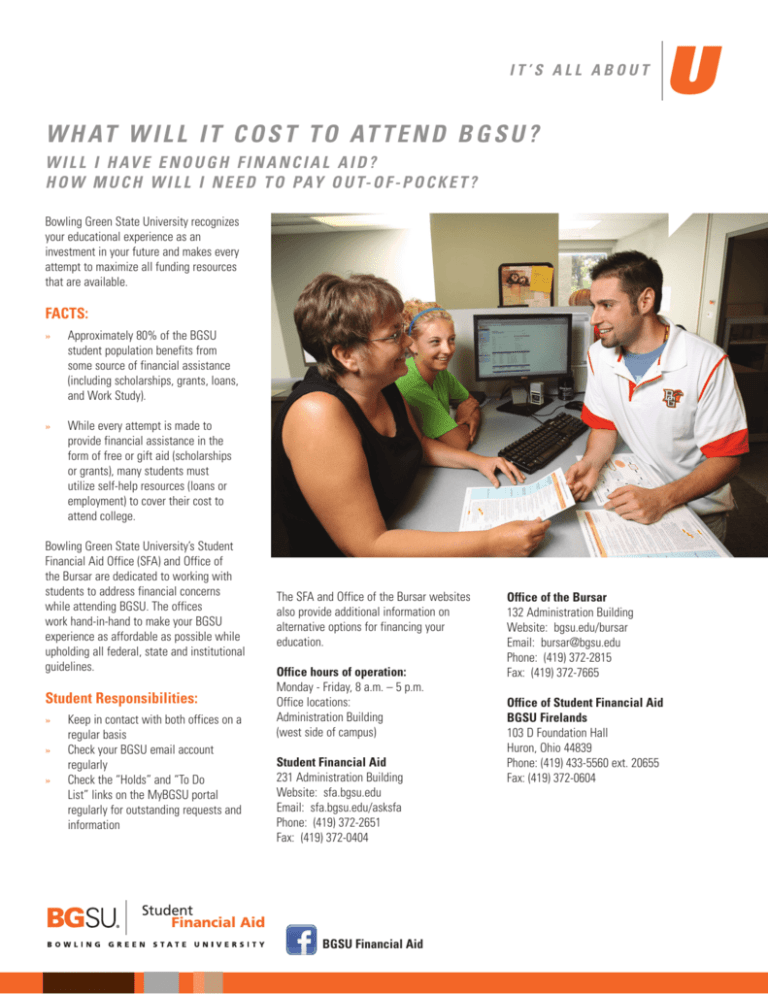
IT’S ALL ABOUT U W H AT W I L L I T C O S T T O AT T E N D B G S U ? W I L L I H AV E E N O U G H F I N A N C I A L A I D ? H O W M U C H W I L L I N E E D T O PAY O U T- O F - P O C K E T ? Bowling Green State University recognizes your educational experience as an investment in your future and makes every attempt to maximize all funding resources that are available. FACTS: » Approximately 80% of the BGSU student population benefits from some source of financial assistance (including scholarships, grants, loans, and Work Study). » While every attempt is made to provide financial assistance in the form of free or gift aid (scholarships or grants), many students must utilize self-help resources (loans or employment) to cover their cost to attend college. Bowling Green State University’s Student Financial Aid Office (SFA) and Office of the Bursar are dedicated to working with students to address financial concerns while attending BGSU. The offices work hand-in-hand to make your BGSU experience as affordable as possible while upholding all federal, state and institutional guidelines. Student Responsibilities: » » » Keep in contact with both offices on a regular basis Check your BGSU email account regularly Check the “Holds” and “To Do List” links on the MyBGSU portal Student regularly for outstanding requests andAid Financial information The SFA and Office of the Bursar websites also provide additional information on alternative options for financing your education. Office hours of operation: Monday - Friday, 8 a.m. – 5 p.m. Office locations: Administration Building (west side of campus) Student Financial Aid 231 Administration Building Website: sfa.bgsu.edu Email: sfa.bgsu.edu/asksfa Phone: (419) 372-2651 Fax: (419) 372-0404 Student Financial Aid BGSU Financial Aid Office of the Bursar 132 Administration Building Website: bgsu.edu/bursar Email: bursar@bgsu.edu Phone: (419) 372-2815 Fax: (419) 372-7665 Office of Student Financial Aid BGSU Firelands 103 D Foundation Hall Huron, Ohio 44839 Phone: (419) 433-5560 ext. 20655 Fax: (419) 372-0604 W H AT C O S T C A N B E C O V E R E D B Y MY FINANCIAL AID? When considering costs to attend college, you must consider both direct educational costs (determined by the BGSU Board of Trustees) as well as indirect educational costs (variable based on the choices you make). When determining how much financial aid a student may receive each year SFA uses both direct costs and an average indirect cost based on student surveys and consumer price index (CPI) values. Direct Educational Costs For the 2014-2015 financial aid year the following direct educational costs are part of the Cost of Attendance (COA): Firelands Campus – Undergraduate – Full-time Enrollment Main (Bowling Green) Campus – Undergraduate – Full-time Enrollment Tuition (Instructional and General Fees) $10,590 Room (Based on Standard Double) Meals (Based on Bronze Meal Plan) $4,931 $5,160 Room (Based on Standard Double) NA $3,084 Meals (Based on Bronze Meal Plan) NA Registration Fee $16 Registration and Facility Fee $136 Career Services and Counseling Center Fee (Amount based on Freshman status @ 15 credit hrs) TOTAL DIRECT EDUCATIONAL COST (Ohio Resident) Tuition (Instructional and General fees) $61 TOTAL DIRECT EDUCATIONAL COST (Ohio Resident) $4,947 Non-Resident Fee (If applicable) $7,308 $19,031* Non-Resident Fee (If applicable) $7,308 TOTAL DIRECT EDUCATIONAL COST (Non-Ohio Resident) $26,339* TOTAL DIRECT EDUCATIONAL COST (Non-Ohio Resident) $12,255 *Individual costs may vary if living in a non-standard/double room and/or if a meal plan other than the Bronze Meal Plan is selected. Financial aid packages will still be based on the above amounts. Financial Aid Cost of Attendance (COA) For 2014-2015 the total COA used by SFA to reflect both the direct and indirect costs to attend BGSU are listed below. The indirect educational costs include an average books and supplies expense of $1,050 per year. Transportation, miscellaneous/personal, as well as other optional fees (legal service, green fee) are included as part of indirect educational costs for financial aid consideration. Firelands Campus – Undergraduate – Full-time Enrollment Main (Bowling Green) Campus – Undergraduate – Full-time Enrollment Ohio Resident Ohio Resident Non-Ohio Resident Non-Ohio Resident Student Living On Campus (Any undergraduate student) $24,322 $31,630 Student Living Off Campus (Upperclassmen) $20,858 $28,166 Student Living Off Campus (Upperclassmen) $24,398 $31,760 Student Living with Parents (Commuters) $16,816 $24,124 Student Living with Parents (Commuters) $22,196 $29,504 HOW ARE MY FINANCIAL AID AWA R D S D E T E R M I N E D ? Federal and state financial aid awards are determined based on predefined formulas. Some awards are considered need-based awards and others are considered non-need-based awards. The sum of all awards (regardless of need) may not exceed the student’s COA. Need-based Aid Need-based aid is determined by using the Expected Family Contribution (EFC) that is derived from the information provided on the Free Application for Federal Student Aid (FAFSA). The EFC is the minimum amount of money the federal government feels you and/or your family should be able to contribute towards your educational expenses on an annual basis. Please note, your costs not covered by free or gift aid (i.e., scholarships and grants) are often much greater than the EFC that is calculated. You may need to cover the additional expenses by applying for loans and/or working. The Federal Pell Grant, Federal Supplemental Educational Opportunity Grant (FSEOG), Federal Work Study (FWS), Federal Perkins Loan, Federal Direct Subsidized Loan and the Ohio College Opportunity Grant (OCOG) are all examples of need-based aid. Due to funding limitations, some programs are restricted to those students who have the highest financial need and have their FAFSA on file by our priority date of February 15. In addition, many aid programs have separate and unique criteria that may vary by credit hours of enrollment, grade level and/or EFC range. To determine NEED-BASED aid eligibility the following formula is used: COA (Cost of Attendance) – EFC (Expected Family Contribution) = Financial Need The following example reflects an award package at BGSU in 2014-2015 for the highest financial need undergraduate student based on full-time enrollment (12 or more credit hours). This student is receiving the maximum federal and state aid that is available: $24,322 (On campus/Ohio resident/full-time COA) – $0 (EFC calculated from the FAFSA) =$24,322 (Financial need) Less federal/state gift aid –$5,730 (Pell Grant – maximum award based on $0 EFC) – $1,048 (OCOG – maximum award based on $0 EFC) – $1,000 (FSEOG– must be early FAFSA filer & have $0 EFC) = $16,544(Remaining need after federal/state gift aid is awarded) IT’S ALL ABOUT U Less need-based federal self-help aid –$3,500 (Direct Subsidized Loan – maximum freshman award; $4,500-sophomore; $5,500–junior/senior) – $2,000 (Perkins Loan – must be early FAFSA filer & have EFC no greater than $2,500) –$2,000 (Federal Work Study – must be early FAFSA filer and get an on-campus job) =$9,044 (Remaining need to be covered by scholarships or non-need-based aid) Non-need-based Aid Non-need-based aid is determined by excluding the EFC from the financial aid formula. Because the EFC is not considered, all fully admitted students may qualify for some type of non-needbased financial aid, regardless of what their family income may be. Examples of non-need-based aid include the Federal Direct Unsubsidized Loan, Federal Direct Parent Loan for Undergraduate Students (PLUS), and alternative/private loan (educational loan available through private lenders rather than the federal government). In some cases, credit decisions and additional applications and loan counseling may be required to obtain these funds. To determine NON-NEED-based aid eligibility the following formula is used: COA (Cost of Attendance) –All need-based aid = Non-need-based eligibility Using the above example: – $24,322 (COA) – $15,278 (Need-based aid) = $9,044 (Remaining eligibility for non-need-based aid) Less non-need-based federal aid –$2,000 (Federal Direct Unsubsidized Loan – same amount for all dependent undergraduates) –$7,044 (Federal Direct PLUS Loan - OR - Alternative/ Private Loan) Students are strongly encouraged to apply for scholarships to minimize the amount of loans they (or their parents) may need to borrow. See the BGSU Searchable Scholarship Guide at sfa.bgsu.edu/scholarship_search for more details. In addition, institutional funds vary year to year based on funding. Students are encouraged to file their FAFSA early and to visit the SFA website for additional information regarding grants and loans. The University Scholarships Office website has additional information on scholarships available from BGSU. IF I QUALIFY FOR FINANCIAL AID, WILL I STILL NEED T O PAY S O M E C H A R G E S O U T- O F - P O C K E T ? The amount of out-of-pocket cost will depend on you. You may choose to borrow enough loan money to cover all of your direct expenses or you may choose to sign up for the Installment or Extended Payment Plan (see Office of the Bursar website at bgsu.edu/bursar for additional information) to help spread the cost out and make monthly payments instead. Parking tickets, library fines, and other miscellaneous charges are not typically covered by financial aid and must be paid out-of-pocket. Books and supplies are costs that will vary by student and may require payment out-of-pocket. Transaction Description The following is a sample fall 2014 billing worksheet for an Ohio resident undergraduate, living on campus and attending full time (minimum 12 credit hours). Amounts reflect actual charges for most entering freshmen but will vary by student depending on courses, residence hall and meal plan choices. Billing statements are emailed to students on or around the 2nd of each month and are due on or around the 15th of each month. Fall tuition and room bills are due in July. Spring tuition and room bills are due in December. Credits/Debits (per semester) Tuition (Instructional and General Fees) Worksheet $5,295 Clinical Lab/Course Fee (Estimate) $50 Standard Double Room $2,580 Bronze Meal Plan $1,542 Student Health Insurance (Plan A); Pay for the year in fall *may be waived if covered under another qualifying plan $1,648 Registration Fee $8 Stroh Center Facility Fee $60 Career Services Fee (Based on 12 credit hrs) $18 Counseling Center Fee (Based on 12+ credit hrs) $8 Matriculation Fee (One-time fee for new students) $100 Green Initiatives Fee (Optional) $5 Student Legal Service Fee (Optional) $9 Parking Permit (Annual amount) $100 Total Charges Fall 2014 $11,423 Less Approved Financial Aid (Figures reflect awards based on a $0 EFC) Federal Pell Grant -$2,865 Ohio College Opportunity Grant -$524 Federal Supplemental Educational Opportunity Grant -$500 Federal Direct Subsidized Loan (Net amount) -$1,731 Federal Perkins Loan -$1,000 Federal Direct Unsubsidized Loan (Net amount) -$989 Total Approved Financial Aid (Add fall semester scholarships to this amount, if applicable) -$7,609 Balance Due Less Other Options for Paying Balance (See the “You Have Choices” brochure available online or in SFA and the Office of the Bursar for more details. Federal PLUS Loan (Pending credit approval; net amount without Work Study) $3,814 Payment Ending Balance -$4,328 -$514* -$4,522 -$708* -$3,814 $0 OR Alternative/Private Loan (Pending credit approval; without Work Study) OR Pay out-of-pocket (Cash, check, credit card) OR Payment Plan Options: Extended (10 month annual; $100 fee) OR Installment (4 payments/semester; $35 fee). See the Bursar website for more details. *If your aid covers more than your direct costs, the additional funds will be refunded to you (or the borrower of a PLUS loan). These additional funds may be used for your indirect educational costs, such as buying books and supplies needed for class or paying for gas to get to and from BGSU. Excess funds (refunds) will not be issued until enrollment is confirmed the first week of classes. Students and parents are strongly encouraged to sign up for the eRefund option under the Bursar Bill View/Pay link on My.BGSU.edu at least one month prior to the start of the fall semester in order to expedite the delivery of the excess funds, if applicable. 15FN137
